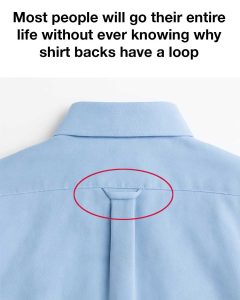In the fast-paced world of fashion, most people wear their clothes without giving much thought to the small details stitched into each garment. One such feature that often goes unnoticed is the small loop found on the back of many dress shirts and casual button-downs. Though it may seem like a decorative flourish or a meaningless extra piece of fabric, this loop actually has an interesting backstory and serves several distinct purposes. Commonly known as the “shirt back loop” or “locker loop,” this little detail has stood the test of time. From its origins in Ivy League culture to its modern-day relevance in fashion, the shirt back loop reveals a great deal about the intersection of style, utility, and cultural history.

The story begins in the 1960s, when the GANT shirt company introduced the locker loop as a practical solution for college students. Back then, Ivy League students often used gym lockers but didn’t always have hangers available. To solve this problem, GANT added a loop of fabric to the back of their shirts, allowing them to be hung conveniently on hooks without getting wrinkled or crumpled. This simple innovation quickly gained popularity, becoming a regular feature on men’s shirts and even influencing styles across other clothing brands. While initially created for function, the loop soon became a quiet symbol of preppy sophistication and smart design.
Over the years, the world of clothing design has gone through dramatic changes. From fabric technology to body-contouring fits, shirts have evolved in many ways. However, the shirt back loop remains, quietly sewn into the center of many shirts. Its survival speaks volumes—not only about its original usefulness but also about how fashion can adopt and repurpose practical elements. In today’s world, where clothing often serves both performance and aesthetic needs, the back loop is a detail that does double duty: it’s functional, but it also adds personality.
One of the most enduring uses of the shirt back loop is still the one it was originally designed for—hanging a shirt without a hanger. Whether you’re in a gym locker room, a college dorm, or just working with a small closet space, being able to hang your shirt by this loop can be incredibly convenient. It helps keep the shirt from wrinkling and gives users a simple, effective storage option when a hanger isn’t available. For many people, especially those who travel or commute regularly, this can make a real difference in their daily routine.
Beyond utility, the shirt back loop has also become a subtle fashion element. In some designs, the loop is made in a contrasting color or a different material, adding a dash of visual interest to the back of the shirt. Fashion designers have embraced it as a nod to heritage style, often using it to give their shirts a more vintage or academic feel. For fans of classic American fashion, the back loop brings to mind collegiate charm and a sense of timelessness that never goes out of style.
Interestingly, the loop has another practical benefit that many people don’t realize—it can help when drying shirts. Instead of stretching a shirt over a hanger or laying it flat to dry, some prefer to hang it by the back loop. This helps the shirt retain its shape and prevents marks that hangers can leave on the shoulders. For those who care about the longevity of their garments, especially expensive or delicate shirts, this is a low-key but valuable feature.
But the loop isn’t just a holdover from the past—it has become part of the retro resurgence. Vintage styles are hugely popular in today’s fashion world, and features like the shirt back loop serve as subtle reminders of earlier eras. Wearing a shirt with a back loop can make someone feel connected to the past, tapping into the charm of classic menswear without appearing outdated. It’s a smart way for designers to blend nostalgia with contemporary tastes.
In some cases, having a shirt with a back loop even speaks to the overall quality of the garment. High-end brands often include such details intentionally, using them as quiet indicators of craftsmanship. When a designer adds a loop, it typically means the shirt was carefully thought through from collar to hem. That attention to detail can set a garment apart, making it more appealing to consumers who appreciate refined construction and subtle touches.
There’s also an interesting cultural side to the shirt back loop. Among Ivy League students in the mid-20th century, there was a quirky tradition tied to this feature. If a student was in a committed relationship, they would cut off the loop as a signal that they were “taken.” On the flip side, some girls would wear the guy’s looped shirt as a symbol of their connection. Though this tradition has mostly faded, it adds a layer of social meaning to what might otherwise be dismissed as a random piece of fabric.
In modern fashion, the back loop has been reimagined in various creative ways. Some designers place loops in unusual spots or use them purely as decoration rather than function. Others double up on loops or integrate them with branding elements. The loop’s flexibility proves that even small features can evolve while still honoring their roots. As clothing styles shift with the times, the shirt back loop continues to find its place, adapting to new aesthetics and uses.
What’s fascinating is that despite all these changes, many people still don’t know what the loop is for. They may see it, touch it, or even use it without thinking twice. Yet this tiny strip of fabric holds decades of fashion history and clever design within its simple form. From locker rooms to fashion runways, it has traveled far beyond its humble beginnings. For those who take a moment to consider it, the shirt back loop offers a quiet but meaningful insight into how even the smallest design features can tell a story.
In the end, the shirt back loop is much more than just an overlooked detail. It is a surviving artifact of practical design, an emblem of a bygone fashion culture, and a versatile element that continues to evolve. Whether you use it to hang a shirt, appreciate it as part of a vintage aesthetic, or simply wear it without ever giving it a thought, this tiny loop carries with it a rich legacy that reflects the broader story of fashion itself.





